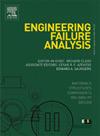Failure analysis of atmospheric relief diaphragm in the low pressure steam turbine
IF 4.4
2区 工程技术
Q1 ENGINEERING, MECHANICAL
引用次数: 0
Abstract
In this study, the causes of failure and prevention methods for the atmospheric relief diaphragm in a low-pressure steam turbine were evaluated. The atmospheric relief diaphragm is designed to vent and burst at its center when the pressure in the exhaust housing exceeds 0.7 barG due to steam. However, visual inspection revealed that failure occurred along the flange mounting, rather than at the center of the diaphragm. Fatigue failure was identified as the cause, based on SEM analysis. Internal pressure fluctuations in the turbine caused bending along the fixed edge of the diaphragm. To confirm the occurrence of fatigue failure, finite element analysis was performed using a maximum internal pressure of 0.023 barG and a frequency of 60 Hz. The maximum deformation was 18.8 mm, which is less than the distance between the diaphragm and the knife, 30 mm. However, the maximum stress was 23.7 MPa, which exceeded the fatigue strength of A1050, 15 MPa, with stress concentration at the diaphragm edge, confirming edge fatigue failure prior to central knife failure. To identify an alternative material, finite element analysis was conducted using higher fatigue strength than A1050 under the same conditions. While the maximum stress was similar to that of A1050, it was below the fatigue strength of the alternative materials. Consequently, to prevent unexpected failures, it is recommended to use materials with higher fatigue strength than A1050 to enhance fatigue life of the diaphragm.
低压蒸汽轮机中大气泄压膜片的失效分析
本研究评估了低压蒸汽轮机中大气泄压隔膜的故障原因和预防方法。大气泄压隔膜的设计是,当排气装置中的蒸汽压力超过 0.7 barG 时,隔膜中心会发生泄压和爆裂。然而,目测检查发现,故障发生在法兰安装处,而不是隔膜中心。根据扫描电镜分析,疲劳故障被确定为故障原因。涡轮机内部压力波动导致隔膜固定边缘弯曲。为了确认疲劳失效的发生,使用 0.023 barG 的最大内部压力和 60 Hz 的频率进行了有限元分析。最大变形量为 18.8 毫米,小于隔膜与刀之间 30 毫米的距离。然而,最大应力为 23.7 兆帕,超过了 A1050 的疲劳强度(15 兆帕),应力集中在隔膜边缘,证实边缘疲劳失效先于中心刀失效。为确定替代材料,在相同条件下使用比 A1050 更高的疲劳强度进行了有限元分析。虽然最大应力与 A1050 相似,但低于替代材料的疲劳强度。因此,为防止意外失效,建议使用疲劳强度高于 A1050 的材料,以提高隔膜的疲劳寿命。
本文章由计算机程序翻译,如有差异,请以英文原文为准。
求助全文
约1分钟内获得全文
求助全文
来源期刊

Engineering Failure Analysis
工程技术-材料科学:表征与测试
CiteScore
7.70
自引率
20.00%
发文量
956
审稿时长
47 days
期刊介绍:
Engineering Failure Analysis publishes research papers describing the analysis of engineering failures and related studies.
Papers relating to the structure, properties and behaviour of engineering materials are encouraged, particularly those which also involve the detailed application of materials parameters to problems in engineering structures, components and design. In addition to the area of materials engineering, the interacting fields of mechanical, manufacturing, aeronautical, civil, chemical, corrosion and design engineering are considered relevant. Activity should be directed at analysing engineering failures and carrying out research to help reduce the incidences of failures and to extend the operating horizons of engineering materials.
Emphasis is placed on the mechanical properties of materials and their behaviour when influenced by structure, process and environment. Metallic, polymeric, ceramic and natural materials are all included and the application of these materials to real engineering situations should be emphasised. The use of a case-study based approach is also encouraged.
Engineering Failure Analysis provides essential reference material and critical feedback into the design process thereby contributing to the prevention of engineering failures in the future. All submissions will be subject to peer review from leading experts in the field.
 求助内容:
求助内容: 应助结果提醒方式:
应助结果提醒方式:


